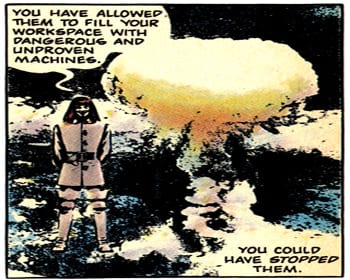Today is Tuesday, and that means Joe McCulloch has your Week in Comics! New Sacco, new oversize reprints, new this, new that.
We also have Sean T. Collins's review of Jean-Pierre Filiu and David B.'s history of U.S./Middle East relations, Best of Enemies. An excerpt:
[David B.] is one of contemporary comics’ true visionaries, the speaker of a visual language of his own devising. Despite personal, cultural, and surface-visual connections (all that high-contrast black-and-white) that might make it look otherwise, as an image-maker he has much more in common with, say, Jack Kirby than with Marjane Satrapi. This gives everyone and everything he depicts a hyperreal aura, and in Best of Enemies he goes full-throttle on it. The headdress of an imperious ambassador becomes a globe the pirate ships whose attacks he permit circumnavigate. A stand-in for the WWII-era British government becomes a three-faced Janus-like figure, issuing contradictory proclamations about the future of the region out of every mouth. The chronically bedridden Mossadegh becomes a disembodied set of pajamas, wielding a scimitar against the floating Sauron-like eyes of British spies and provocateurs. America’s chief goon in Iran, spymaster Kermit Roosevelt, is a virtual gremlin, his rictus-like grin affixed to his diminutive frame as he hides beneath a blanket to conduct clandestine meetings with the Shah. Bought-off officials open their jaws like Hungry Hungry Hippos to swallow American dollars. Even as familiar a figure as FDR himself has his eyebrows transformed into a cigarette to demonstrate the gravity of his banning smoking while negotiating with the Saudis.
Elsewhere there are many comics-related things worth your time, if you're so inclined. For example...
—Jeet Heer takes to the Globe and Mail to report on what made superheroes gay even before recent developments.
—Derik Badman points out a recent essay by comics scholar Hannah Miodrag on literary comics. I haven't read it, but based on his description, she seems to be using an argument similar to the one I used to make a lot over on Comics Comics over the past few years—it's not theme and subject matter that makes a comic "literary," but rather the use of text itself. It's the definition that makes the most sense to me, and one that avoids the problems that come along with the more standard one.
—Tom Heintjes has a roundtable with several people carrying on the family business, in this case comic strips, including Brian and Greg Walker, Jeff Keane, and Mason Mastroianni.
—Alan Moore and Jacen Burrows's Neonomicon has been challenged and pulled from a South Carolina library. I don't think any books should be off-limits for libraries, and hope that it is restored soon. But that book... it's not hard to imagine that presumably unprepared mother's reaction.
—Paul Pope links to his own 1996 interview with art theorist Rudolf Arnheim, which I plan to read post-haste.
—Two unusual reviews of Before Watchmen, from the Mindless Ones-affiliated Andrew Hickey, and from Alan Moore biographer Lance Parkin, reporting in from an alternate dimension.
—Not comics. Via Sean Howe, the secret history of Lisa Lyon, the bodybuilder used by Frank Miller as a model for his Elektra character, and her "connections to Robert Mapplethorpe, voodoo, Arnold Schwarzenegger, PCP, Huey Newton, cocaine, Jack Nicholson, and Day of the Dolphin."






